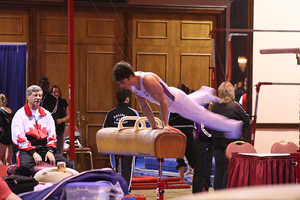
Source: “Doing research,” Viewoftheworld, Flickr
In order to collect the best possible data, facts, and ideas, you need to figure out two things: (1) how many sources you will need and (2) what kind you will need. Usually the directions for an assignment or your teacher will tell you how many sources to use. If you have to decide, do so based on the length of your paper and what your paper is about. Your argument may be such that you don’t need much evidence to back up your claims.
On the other hand, you may be arguing about a serious and controversial issue that requires a great deal of evidence if the reader is to be persuaded to accept your side of the argument. Sources can include class textbooks, newspapers, professional journals, websites, etc. Most persuasive essays pull from at least three sources so that readers can consider a variety of support information. For this lesson, you will use three sources—one Internet source and two print sources.
Now that you have an idea of how many sources you will need, think about how to gather the right information. Not only do you need to find one electronic source and two print sources, but you need to find the best data, facts, and ideas that are available to support your arguments and to refute counterarguments. To do this you must be a close reader and put on your best investigative hat.

Source: “The Detective,” paurian, Flickr
Investigators search thoroughly, and that’s exactly what you’ll need to do. You will read articles and find the best facts and statistics to back up your position. Knowing which sources are good and which ones are not is a skill that comes with knowledge and experience. Good sources are reliable sources. Good sources are also valid sources. Even when you have reliable and valid sources, they may not be right for your essay. Ask a few questions like the ones listed below to evaluate the reliability and validity of a source. If you need help, ask your teacher, librarian, or a parent to help you decide if a source is credible. The five questions that follow can help you decide whether a source is good for your essay or not.
- Is the author a respected authority on the subject? How can you know this?
You’re in luck; you have search engines at your fingertips to help you answer this question. Type in the author’s name and see what pops up in the search results. For example, if you find a writer who has written several articles about women in sports for credible websites and publications, you might consider that person’s work credible, especially if the writer is a psychologist, educator, or perhaps a well-known sports writer. If the writer is a person with no real training or experience in the topic, you will probably want to nix him or her as a source. - Does the author support opinions with strong arguments and logical reasoning?
As you read, do you discover information that makes the writer’s argument strong and convincing? You will see some examples of valid, logical arguments later in this section. - How current is the information?
It’s important to have current information. A good rule of thumb is to use information published in the last 10 years. If a source is older, you may not want to use it unless it pertains to information that doesn’t change (i.e., historical dates). If you can’t find the date the information was published, which sometimes happens with Internet sources, use the context of the sources to see if you can guess when it was written. - Does the author use supporting evidence to back up claims?
If the article you’re reading seems to be the author’s opinion with little or no evidence to back up claims, it is not a valid or reliable source. If, however, the author quotes or uses information from experts, then you might consider using the source, provided that the author’s sources are credible. Yes, you need to check not only that the author uses expert opinion, but also that the expert opinion is not from the likes of Dr. Jekyll or Dr. Frankenstein! - Does the information in this source match information found in other sources?
If you find information that is very different from other sources on the topic you’re researching, slow down and think about why it’s different. Check the author’s credentials. See when it was written and ask yourself why this information might be different from everything else. You might use this information in your essay to illustrate a different opinion, or you might want to avoid it if you’re trying to construct a reasonable argument. Sometimes a radically different idea may topple or confuse your argument, especially if it contradicts your other sources.
Source: Women’s Basketball vs. Illinois State 11/2/2010, Illinois Springfield, Flickr
Let’s narrow the topic of women in sports. For this essay, you will argue the following: “Women should be allowed to play in men's sports.” Read the summaries from the three possible sources below and evaluate which ones contain information that best supports this position.
| Website: ESPNW | European Study: “Sports, Media and Stereotypes, Women and Men in Sports and Media” | Book Review: Taking the Field: Women, Men, and Sports |
|---|---|---|
| There may be places for women in the men’s leagues. Former Packers vice president Andrew Brandt said a woman might be able to play as a kicker. Former Red Sox general manager Dan Duquette said a woman might break into baseball as a knuckleballer. | Most of the European sports were developed to suit the male body above all, and their standards have traditionally been set by men, even if many physical activities are just as well or even better suited for women than men. A case in point is gymnastics, where women are generally accepted as being more flexible and are typically smaller, an advantage in this sport. Men respond to this by not competing in the areas of gymnastics where these features matter most, such as the balance beam. Instead, they emphasize the gymnastic events best suiting them, for example the rings. In this way men simply refrain from competing under conditions not suitable to them, whereas women frequently force themselves to fit into systems created by and for men. | In the past, when sport simply excluded girls, the equation of males with active athletic power and of females with weakness and passivity seemed to come easily, almost naturally. Now, however, with girls’ and women’s dramatic movement into sport, the process of exclusion has become a bit subtler, a bit more complicated—and yet, as Michael Messner shows us in this provocative book, no less effective. |

Source: Warmups, Martin Cathrae, Flickr
The information from ESPNW contains the opinions of two experts in the field of professional sports. Andrew Brandt is the former vice president of the Green Bay Packers, an NFL team, and Dan Duquette is the former general manager of the Red Sox, a major league baseball team. Both suggest ways that women can enter professional sports, so this information may work in your persuasive essay.
The second box contains information from the Centre for Gender Equality in Iceland, whose funding is from the European Commission’s Community Framework on Strategy on Gender Equality. The excerpt is about how the development of sports initially favored males and set the rules of competition to benefit men over women. This information may also work in your persuasive essay because it provides a fact: European sports were developed with men’s bodies in mind. It states that women force themselves into sports that were created for men because they want to compete, whereas men may not compete in sports that are ill-suited to them or in which they don’t have an advantage. Men and women’s gymnastics is used as an example.

Source: “San Francisco Co-Ed Advertising and Marketing Softball League,” Eric Molina, Flickr
The last box is from a book review of Taking the Field: Women, Men, and Sports. The excerpt says the book is about how sports didn’t include girls and for the most part that was fine, but now girls and women want more inclusion in the world of sports. Although this source sounds like it would contain information supportive of your position on the topic of women in sports, you may not want to use it because the excerpt does not present specific data or facts. Also, this box presents a summary or review of the book, not information from the book itself, which is a good reason not to use it. If you read the book, then it might be useful, but the book review alone isn’t helpful to your argument.